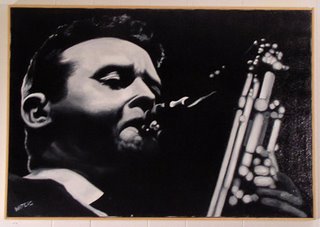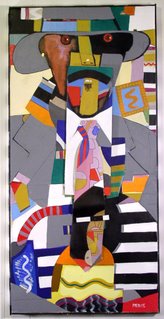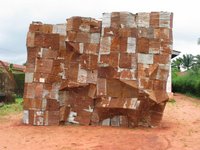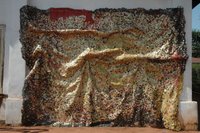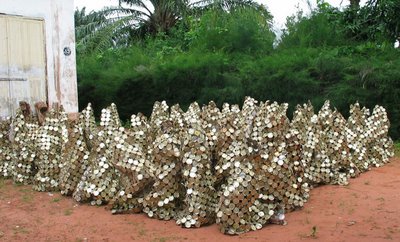New England art critics awards
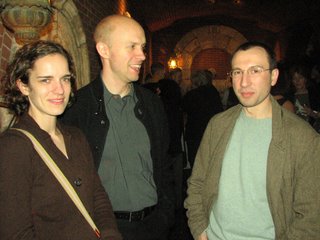 Are local artists not museum worthy? That was the blunt question I was wondering about on the train home from an art critics awards ceremony at Boston’s Gardner Museum Wednesday night.
Are local artists not museum worthy? That was the blunt question I was wondering about on the train home from an art critics awards ceremony at Boston’s Gardner Museum Wednesday night. The New England chapter of the International Association of Art Critics (AICA) presented 36 awards for best 2005 and 2006 art exhibits and events, plus a special recognition award to Boston Institute of Contemporary Art Director Jill Medvedow for leading the creation of the flashy new ICA building, which opened on the South Boston waterfront last December. (Pictured above, Julia Fethergill, Bernard Toale Gallery's Joseph Carroll and Fethergill's husband, artist Joe Zane, whooping it up at the AICA awards.)
One of the things that struck me was that of the 16 New England museum shows awarded prizes, only three featured artists who live(d) in New England. And the number of living local artists in these shows was small. (See complete list of awards at bottom.)
Awarded first place for best thematic museum show was “Painting Summer in New England” at the Peabody Essex Museum in Salem, Massachusetts,
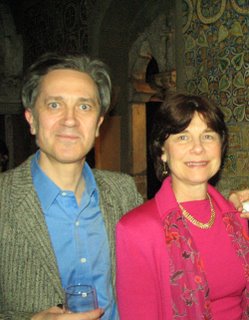
organized by Trevor Fairbrother (at left with Gardner Director Anne Hawley). It featured some 80 artists, many who lived in New England, but if you look at the 13 still alive you find Cape Codders and Mainers, some summer visitors from outside New England, and one Bostonian, Allan Crite.
“Ahistoric Occasion” at MassMoCA in North Adams, Massachusetts, took second place in this category. Among its 11 artists was a token New Englander, Peggy Diggs of Williamstown, Massachusetts.
The top prize for best architecture or design show went to “A Chain of Events: Modernist Architecture on the Outer Cape: Marcel Breuer to Charles Jencks” at the Provincetown Art Association and Museum.
Why didn’t New England critics (I’m not an AICA member) honor more museum shows by local artists? (Is three out of 16 enough?)
A first question is are there local museum shows of great living local artists? The Brooklyn Museum’s recent retrospective of Southfield, Massachusetts, painter Walton Ford, was definitely award worthy, but has no New England venue. The retrospective of Brookline’s Maria Magdalena Campos-Pons that just opened in Indianapolis isn’t scheduled to come here either.
But 2006 did offer a number of local museum exhibits by artists who reside locally – photographer Laura McPhee and painter Ambreen Butt at Boston’s Museum of Fine Arts; painter Sarah Walker at the Rose Art Museum at Brandeis in Waltham; the Foster Prize finalists exhibition at the ICA; and several shows at the Danforth Museum in Framingham and the DeCordova Museum in Lincoln.
“Wunderground” at the RISD Museum in Providence, which featured pretty much every artist from Providence’s lively underground art scene of the past decade, should have gotten some sort of award. It was a wild and wooly show, messy and imperfect certainly, but much more exciting and representing more important art developments – important nationally – than “Painting Summer” or “Ahistoric.” Or most of the other museum shows honored.
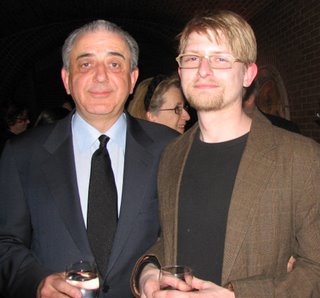 Still, the AICA’s picks are telling. Frankly, a lot of the other museum shows featuring local artists weren’t anything to go ape about. Blame the artists. Blame the curators. (Hey, blame us critics, too.) But what will we do to foster more exciting art-making and more exciting museum exhibitions of local art around here?
Still, the AICA’s picks are telling. Frankly, a lot of the other museum shows featuring local artists weren’t anything to go ape about. Blame the artists. Blame the curators. (Hey, blame us critics, too.) But what will we do to foster more exciting art-making and more exciting museum exhibitions of local art around here?The 2007 AICA Awards:
Best Monographic Museum Show, New England
First Place: “Chuck Close Prints: Process and Collaboration,” organized by the Blaffer Gallery, Art Museum of the University of Houston and the Addison Gallery of American Art; curator, Terrie Sultan.
Second Place: “Joan Snyder: A Painting Survey 1969-2005,” organized by the Danforth Museum of Art; curator, Katherine French. (Pictured above, for no particular reason, AICA event host Arthur Dion of Gallery NAGA and Big Red & Shiny pooh-bah Matthew Nash.)
Best Thematic Museum Show, New England
First Place: “Painting Summer in New England,” organized by the Peabody Essex Museum of Art; curator, Trevor Fairbrother.
Second Place: “Ahistoric Occasion: Artists Making History,” organized by Massachusetts Museum of Contemporary Art; curator, Nato Thompson.
Best Monographic Museum Show, Boston
First Place: “America Starts Here – Kate Ericson and Mel Ziegler 1985-1995,” organized by Skidmore College and MIT List Visual Arts Center; curators, Ian Berry and Bill Arning.
Second Place: “David Hockney Portraits,” organized by Boston Museum of Fine Arts; curators, Sarah Howgate and Barbara Stern Shapiro.
Best Thematic Museum Show, Boston-area
First Place: “On the Edge: Contemporary Chinese Artists Encounter the West,” organized by the Iris and Gerald Cantor Center for the Visual Arts at Stanford University and the Davis Museum and Cultural Center, Wellesley College; curator, Britta Erickson.
Second Place: “Choreographic Turn: Daria Martin, Peter Welz in Collaboration with William Forsythe,” organized by MIT List Visual Arts Center; curator, Bill Arning.
Best Installation or Single Work of Art in a Museum, New England
First Place: “Xu Bing: Any Opinions?” organized by the Davis Museum and Cultural Center, Wellesley College; curator, Anja Chavez.
Second Place: “Carsten Holler: Amusement Park,” organized by the Massachusetts Museum of Contemporary Art; curators, Joe Thompson, Nato Thompson, and Larry Smallwood.
Best Installation or Single Work of Art in a Museum, Boston-area
First Place: “Jessica Stockholder: Rawhide Harangue of Aching Indices as Told by Light,” organized by Barbara and Steven Grossman Gallery, School of the Museum of Fine Arts; curator, Joanna Soltan.
Second Place: “Paul Chan 1st Light, Momentum 5,” organized by the ICA Boston; curator, Bennett Simpson.
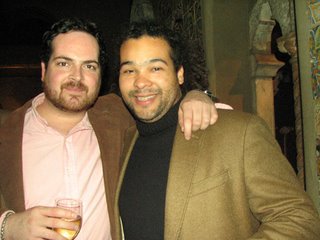
Best Show in a Commercial Gallery, Boston-area
First Place: Taylor Davis, Samson Projects. (Above, artist and curator Eddie Martinez with Samson Projects honcho Camilo Alvarez.)
Second Place: Neeta Madahar “Nature Studies,” Howard Yezerski Gallery.
Best Show in a Commercial Gallery, New England
First Place: Neal T. Walsh, Gallery Agniel, Providence, RI; curator, Sara Agniel.
Second Place: “New Visions: Mike Berg, Paul Chojnowski, and Ray Charles White,” Harrison Gallery, Williamstown, MA; curator, Jo Ellen Harrison.
Best Show of an Emerging Artist, Boston-area
First Place: Joe Zane “Personality,” Allston Skirt Gallery.
Second Place: Gary Duehr “Car Obscura,” Gallery Kayafas.
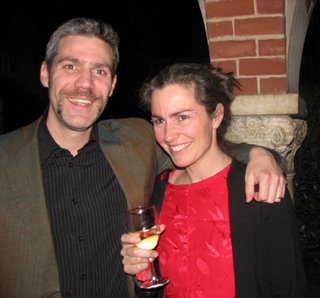
Best Show in an Alternative Space, Boston-area
First Place: Joe Wardwell “Solo,” Green Street Gallery; curator: James Hull. (Above, Wardwell with Tony Fair.)
Second Place: Liz Nofziger “Grate (Black Gold); Second Gallery; curator, Rebecca Gordon.
Best Monographic Show in Institutional/University Gallery, Boston-area
First Place: Shintaro Miyake “The Beaver Project,” organized by the Sara and David Bakalar Gallery, Massachusetts College of Art; curator, Lisa Tung.
Second Place: Penelope Jencks, organized by Boston University School of the Visual Arts, 808 Gallery; curator, Lynne Cooney.
Best Group Show in Institutional/University Gallery, Boston-area
First Place: “Pattern Language: Clothing as Communicator,” organized by the Tufts University Art Gallery; curator, Judith Fox.
Second Place: “Four Artists in Search of the Intangible,” organized by Trustman Art Gallery at Simmons College; curator, Bob Oppenheim.
Best Group Show in Institutional/University Gallery or Non-Profit Space, New England
First Place: “From Baja to Bar Harbor: Transnational Contemporary Art,” organized by The Institute of Contemporary Art at Maine College of Art. Portland, Maine; curator, Toby Kamps.
Second Place: “Voice: Women in Contemporary Art,” organized by the Providence Art Club. Providence, RI; curator, Kara Walker.
Best Group Show in a Commercial Gallery, Boston-area
First Place: “Don't Abandon the Ship,” Allston Skirt Gallery; curator, Eddie Martinez.
Second Place: “Katherine Jackson, Pamela Harris, Eva Lee, William Weiss: New Works on Paper,” O·H+T Gallery.
Best Project in a Public Space, Boston-area
First Place: Michael Dowling “Medicine Wheel,” Cyclorama, Boston Center for the Arts.
Second Place: Ellen Driscoll “Filament/Firmament,” Cambridge Arts Council; curator, Hafthor Yngvason.
Best Architecture or Design Show
First Place: “A Chain of Events: Modernist Architecture on the Outer Cape: Marcel Breuer to Charles Jencks,” organized by the Provincetown Art Association and Museum; curators, Bob Bailey and Peter McMahon.
Second Place: “Light My Fire: Rock Posters from the Summer of Love,” organized by the Museum of Fine Arts Boston; curator, Patrick Murphy.
Best Historical Show, Boston-area
First Place: “Gentile Bellini and the East,” organized by the Isabella Stewart Gardner Museum; curators, Alan Chong and Caroline Campbell.
Second Place: “Frank Stella 1958,” organized by Harvard University Art Museums, Arthur M. Sackler Museum; curators, Harry Cooper and Megan R. Luke.
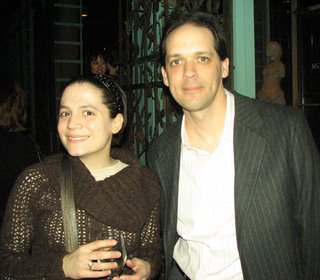
Best Exhibition of Time Based Art, Boston-area (Film, Video, and Performance)
First Place: Brian Knep “Deep Wounds,” Memorial Hall, Harvard University; organized by the Office of the Arts at Harvard and Department of Systems Biology, Harvard Medical School. (Above, Knep with AXIOM gallery's Phaedra Shanbaum.)
Second Place: “ArtRages Festival,” organized by Mobius.
Second Annual AICA/ New England Special Recognition Award
Jill Medvedow, director, Institute of Contemporary Art, Boston.
For comparison, here’s my list of the best local art stuff of 2006.
Photos by the Gardner's Katherine Armstrong.





-713747.jpg)
